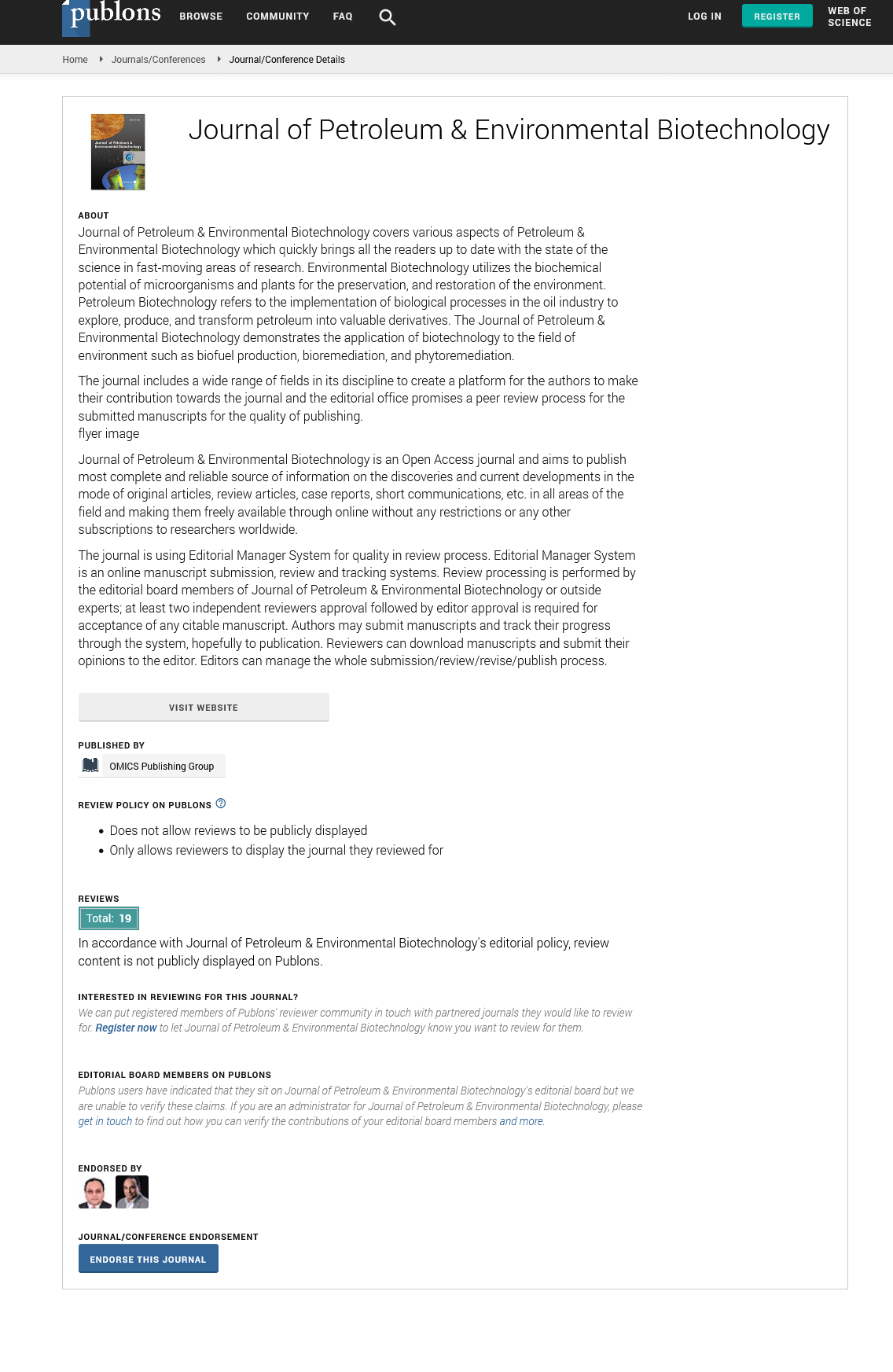Indexed In
- Open J Gate
- Genamics JournalSeek
- JournalTOCs
- China National Knowledge Infrastructure (CNKI)
- Electronic Journals Library
- RefSeek
- Hamdard University
- EBSCO A-Z
- OCLC- WorldCat
- SWB online catalog
- Virtual Library of Biology (vifabio)
- Publons
- MIAR
- Euro Pub
- Google Scholar
Useful Links
Share This Page
Journal Flyer

Open Access Journals
- Agri and Aquaculture
- Biochemistry
- Bioinformatics & Systems Biology
- Business & Management
- Chemistry
- Clinical Sciences
- Engineering
- Food & Nutrition
- General Science
- Genetics & Molecular Biology
- Immunology & Microbiology
- Medical Sciences
- Neuroscience & Psychology
- Nursing & Health Care
- Pharmaceutical Sciences
Opinion Article - (2025) Volume 16, Issue 1
The Role of Glycol Dehydration in Modern Gas Processing and Emission Control
Efstathios Skouras*Received: 01-Mar-2025, Manuscript No. JPEB-25-29353; Editor assigned: 03-Mar-2025, Pre QC No. JPEB-25-29353 (PQ); Reviewed: 17-Mar-2025, QC No. JPEB-25-29353; Revised: 24-Mar-2025, Manuscript No. JPEB-25-29353 (R); Published: 31-Mar-2025, DOI: 10.35248/2157-7463.25.16.602
Description
Glycol dehydration is one of the most widely used natural gas treatment processes, essential for removing water vapor from natural gas streams to prevent the formation of gas hydrates and corrosion in pipelines. The process plays a critical role in meeting pipeline specifications and ensuring the safety, efficiency, and longevity of gas transport and processing infrastructure. At the core of glycol dehydration systems is the use of hygroscopic liquids—primarily triethylene glycol (TEG)—to absorb water from the gas stream. TEG has proven to be an ideal choice due to its high affinity for water, relatively low vapor pressure, chemical stability, and regenerability.
The process begins with the natural gas entering a contactor tower, where it flows upward and comes into contact with lean glycol descending from the top. This counter-current flow maximizes contact time and surface area, allowing the glycol to absorb water vapour from the gas. The "rich" glycol, now saturated with water, exits the bottom of the tower and is sent to the regeneration system. The regeneration unit typically consists of a flash separator to remove hydrocarbons and a reboiler where the rich glycol is heated to drive off the absorbed water. The regenerated lean glycol is then cooled and returned to the contactor for reuse.
Operational parameters, including temperature, pressure, glycol circulation rate, and contactor tray configuration, significantly influence the efficiency of the dehydration process. Typical gas exit dew points achieved with TEG systems are around -40°F, though further reductions can be achieved by modifying the system or using enhanced dehydration methods such as stripping gas or vacuum systems. The use of stripping gas, often methane or dry natural gas, in the reboiler can lower the partial pressure of water, increasing the dehydration capacity of the glycol.
Environmental considerations are becoming increasingly important in the operation of glycol dehydration units. The regeneration process can lead to the emission of Volatile Organic Compounds (VOCs) and Hazardous Air Pollutants (HAPs) such as Benzene, Toluene, Ethylbenzene, and Xylene (BTEX). To mitigate these emissions, facilities may employ condensers, flare systems, or thermal oxidizers. Some advanced systems incorporate closed-loop designs to recover and recycle emissions. Regulatory agencies such as the U.S. Environmental Protection Agency (EPA) have implemented strict guidelines governing emissions from glycol dehydration units, pushing operators to adopt cleaner technologies and better process controls.
Maintenance and reliability of dehydration systems are vital for continuous gas processing operations. Common issues include glycol losses due to entrainment, foaming, and degradation. Entrainment separators or mist extractors are used to minimize glycol carryover in the gas stream. Chemical additives may be used to control foaming, and regular monitoring of glycol quality is necessary to prevent the buildup of degradation products, which can reduce absorption efficiency and damage system components.
From a sustainability perspective, efforts are being made to improve the energy efficiency of glycol dehydration systems. Heat integration and waste heat recovery are increasingly used to reduce fuel consumption in the reboiler. Additionally, there is ongoing research into alternative dehydration methods and advanced glycol formulations with improved water absorption capabilities and lower regeneration temperatures.
In conclusion, glycol dehydration remains an indispensable process in natural gas treatment, balancing operational performance with environmental and regulatory demands. As the energy industry evolves, there is a growing emphasis on optimizing these systems for reduced emissions, improved energy efficiency, and greater reliability. Continued innovation and adherence to best practices will ensure that glycol dehydration systems remain robust and sustainable solutions for natural gas processing.
Citation: Skouras E (2025) The Role of Glycol Dehydration in Modern Gas Processing and Emission Control. J Pet Environ Biotechnol. 16:602.
Copyright: © 2025 Skouras E. This is an open access article distributed under the terms of the Creative Commons Attribution License, which permits unrestricted use, distribution, and reproduction in any medium, provided the original author and source are credited

